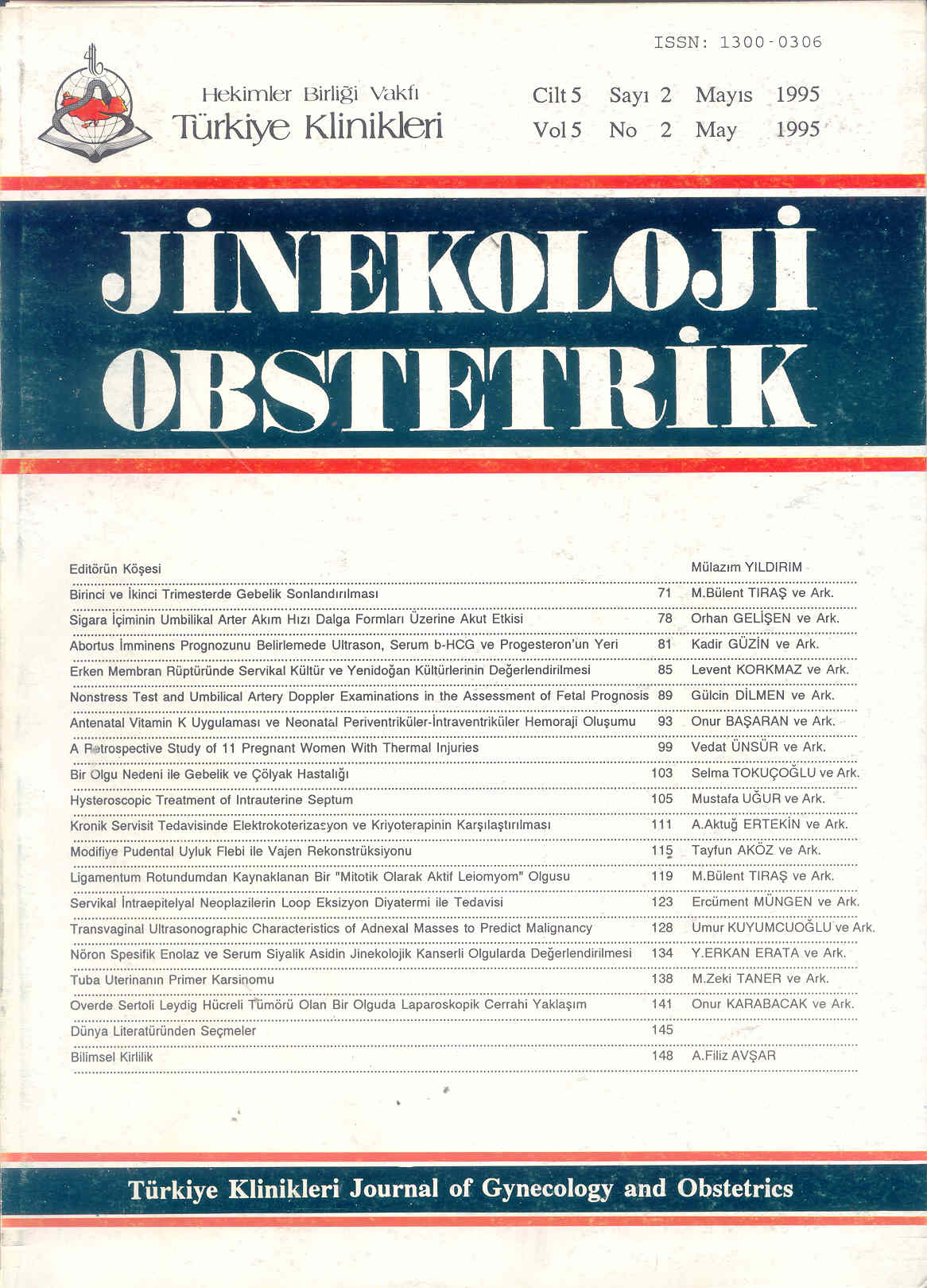Open Access
Peer Reviewed
ARTICLES
2922 Viewed1174 Downloaded
Vaginal Reconstruction With Modified Pudental Thigh Flap
Modifiye Pudental Uyluk Flebi ile Vajen Rekonstrüksiyonu
Turkiye Klinikleri J Gynecol Obst. 1995;5(2):115-8
Article Language: TR
Copyright Ⓒ 2025 by Türkiye Klinikleri. This is an open access article under the CC BY-NC-ND license (http://creativecommons.org/licenses/by-nc-nd/4.0/)
ÖZET
Amaç: Vajen rekonstrüksiyonunda son zamanlarda popülarize olan pudental flepte yaptığımız modifikasyonu ve uyguladığımız olguları sunmak, sonuçları literatür bilgileri ile kıyaslamak. Materyel ve Metod: Çalışmaya Müllerian tipi vajinal agenezili iki ve testiküler feminizasyon sendromlu bir hasta alındı. Bu hastalarda gerekli tetkikleri takiben vajen rekonstrüksiyonu planlandı. Yöntem olarak seçilen pudental uyluk flebi ve rekonstrüksiyonda oluşturulan neovaginanın kontrakte olmasını azaltmak üzere modifikasyon yapıldı. Yöntem sunularak modifikasyon nedeni açıklandı. Bulgular: Postoperatif komplikasyon oluşmadı. Uzun dönemde neovaginada kontraktür gözlenmedi. Fizik muayenede üç ay içinde sağlam ve stabil bir vajen duvarı oluştuğu görüldü. Sonuç: Erken ve geç dönem sonuçlarına göre, uygulanan teknik ve modifikasyon anatomiye uygun ve fonksiyonel vajina oluşturulmasını sağladı.
Amaç: Vajen rekonstrüksiyonunda son zamanlarda popülarize olan pudental flepte yaptığımız modifikasyonu ve uyguladığımız olguları sunmak, sonuçları literatür bilgileri ile kıyaslamak. Materyel ve Metod: Çalışmaya Müllerian tipi vajinal agenezili iki ve testiküler feminizasyon sendromlu bir hasta alındı. Bu hastalarda gerekli tetkikleri takiben vajen rekonstrüksiyonu planlandı. Yöntem olarak seçilen pudental uyluk flebi ve rekonstrüksiyonda oluşturulan neovaginanın kontrakte olmasını azaltmak üzere modifikasyon yapıldı. Yöntem sunularak modifikasyon nedeni açıklandı. Bulgular: Postoperatif komplikasyon oluşmadı. Uzun dönemde neovaginada kontraktür gözlenmedi. Fizik muayenede üç ay içinde sağlam ve stabil bir vajen duvarı oluştuğu görüldü. Sonuç: Erken ve geç dönem sonuçlarına göre, uygulanan teknik ve modifikasyon anatomiye uygun ve fonksiyonel vajina oluşturulmasını sağladı.
ANAHTAR KELİMELER: Vajen rekonstrüksiyonu, uyluk flebi, pudental uyluk flebi
ABSTRACT
Objective: To evaluate the effectiveness of a modified vaginal reconstruction method using pudental thigh flap that has recently become a preferred flap for this purpose, and to compare the results with the literature review. Institution: Ankara Numune Community Hospital, 1st Plastic Surgery Clinic. Material and Methods: Three patients, two with Mullerian vaginal agenesis and one with testicular feminization syndrome were included to this study. All patients underwent vaginal reconstruction operation. We modified the pudental thigh flap that was the preferred method, in order to prevent contraction of neovagina. We presented the technique and explained the reason of the modification. Results: There was no postoperative complication. Neovaginal shrinkage and stenosis were not seen. In physical examination, durable and stable vaginal walls were found in three months. Conclusion: According to early and late postoperative results, the technique and the modification provide a functional and anatomically acceptable neovagina.
Objective: To evaluate the effectiveness of a modified vaginal reconstruction method using pudental thigh flap that has recently become a preferred flap for this purpose, and to compare the results with the literature review. Institution: Ankara Numune Community Hospital, 1st Plastic Surgery Clinic. Material and Methods: Three patients, two with Mullerian vaginal agenesis and one with testicular feminization syndrome were included to this study. All patients underwent vaginal reconstruction operation. We modified the pudental thigh flap that was the preferred method, in order to prevent contraction of neovagina. We presented the technique and explained the reason of the modification. Results: There was no postoperative complication. Neovaginal shrinkage and stenosis were not seen. In physical examination, durable and stable vaginal walls were found in three months. Conclusion: According to early and late postoperative results, the technique and the modification provide a functional and anatomically acceptable neovagina.
MENU
POPULAR ARTICLES
MOST DOWNLOADED ARTICLES





This journal is licensed under a Creative Commons Attribution-NonCommercial-NoDerivatives 4.0 International License.










